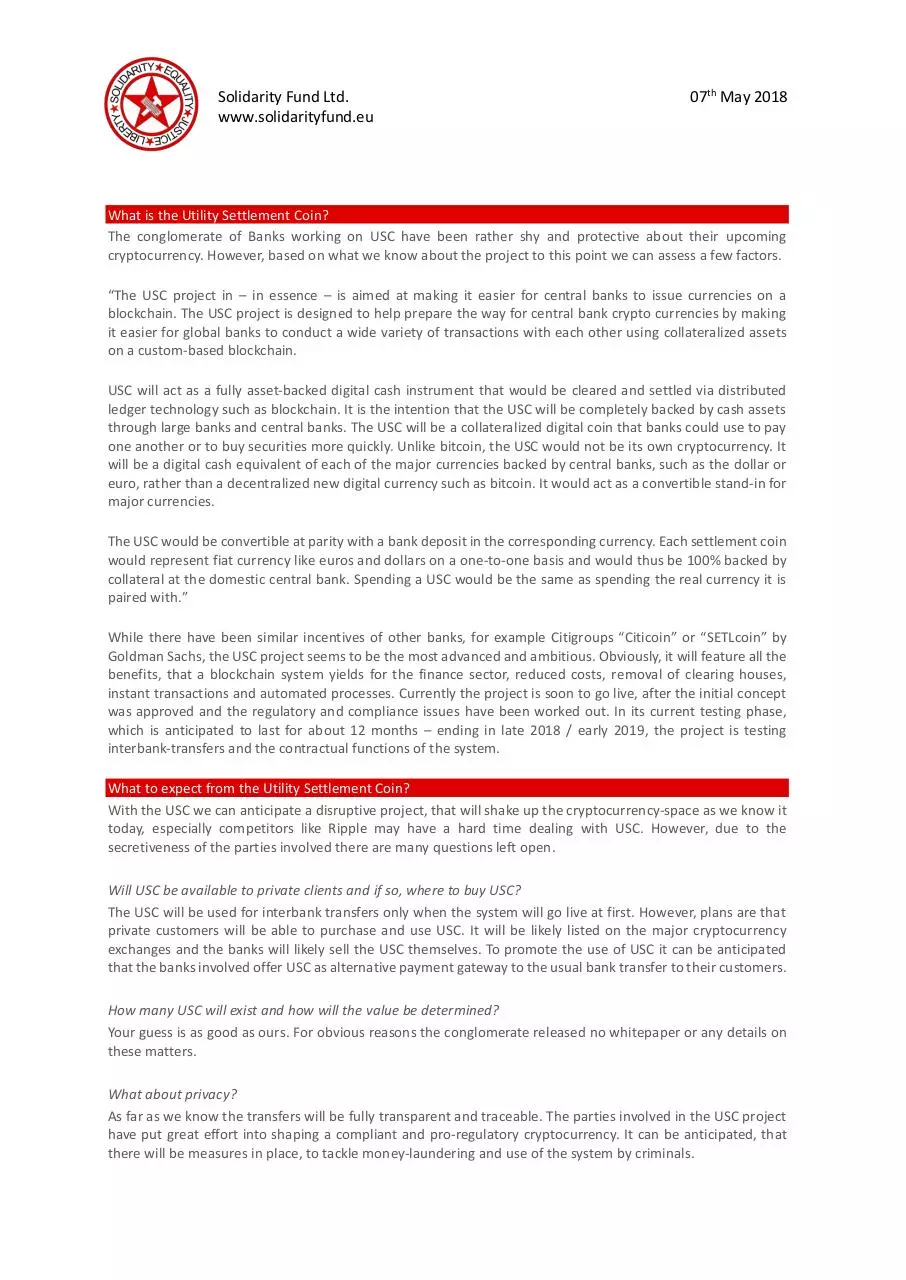SolidarityFund Letter 07thMay18 (PDF)
File information
Author: Ovey
This PDF 1.7 document has been generated by Microsoft® Word 2016, and has been sent on pdf-archive.com on 07/05/2018 at 21:19, from IP address 88.130.x.x.
The current document download page has been viewed 298 times.
File size: 367.45 KB (3 pages).
Privacy: public file



File preview
Solidarity Fund Ltd.
www.solidarityfund.eu
07th May 2018
SOLIDARITY FUND LETTER
The “Solidarity Fund Letter” gives an insight to developments in the cryptocurrency-space that attracts our
attention and surely should attract yours as well. As we are interested in the wellbeing of all our brethren and
sisters, we will never sell you hype in these issues, but present facts, insights, possibilities and dangers
associated with the featured projects. Unlike many solely capitalistic and egocentric personas and groups out
there, we are not interested in striking the highest profit for ourselves, but for our cause. We will donate 10%
of our gains to political parties on the left spectrum throughout Europe and to organizations that are in need of
our help. We will never ask you for donations, membership fees and things alike. Let’s fight the enemy with his
own weapons!
USC UTILITY SETTLEMENT COIN
Introduction
Our first issue will focus on a secretive game-changer - The Utility Settlement Coin (USC) is an attempt by the
private sector to provide a wholesale cryptocurrency. It is a concept proposed by a collection of large private
banks and a fintech firm for a series of digital tokens representing money from multiple countries that can be
exchanged on a distributed ledger platform. The value of each country’s USC on the distributed ledger would
be backed by an equivalent value of domestic currency held in a segregated (reserve) account at the central
bank.
In September 2015 the Swiss bank UBS launched its first Utility Settlement Coin (USC) concept in collaboration
with UK-based blockchain company Clearmatics. They were joined in August 2016 on the project by BNY Mellon,
Deutsche Bank, Santander, broker/dealer ICAP and the financial services firm NEX. Recently we saw the addition
of Barclays, HSBC, State Street, Credit Suisse, MUFG and the Canadian Imperial Bank of Commerce.
At this current point not a lot of facts are presentable about the USC, however, we deem this one of the most
important cryptocurrency projects to come and hence you should know about it.
Solidarity Fund Ltd.
www.solidarityfund.eu
07th May 2018
What is the Utility Settlement Coin?
The conglomerate of Banks working on USC have been rather shy and protective about their upcoming
cryptocurrency. However, based on what we know about the project to this point we can assess a few factors.
“The USC project in – in essence – is aimed at making it easier for central banks to issue currencies on a
blockchain. The USC project is designed to help prepare the way for central bank crypto currencies by making
it easier for global banks to conduct a wide variety of transactions with each other using collateralized assets
on a custom-based blockchain.
USC will act as a fully asset-backed digital cash instrument that would be cleared and settled via distributed
ledger technology such as blockchain. It is the intention that the USC will be completely backed by cash assets
through large banks and central banks. The USC will be a collateralized digital coin that banks could use to pay
one another or to buy securities more quickly. Unlike bitcoin, the USC would not be its own cryptocurrency. It
will be a digital cash equivalent of each of the major currencies backed by central banks, such as the dollar or
euro, rather than a decentralized new digital currency such as bitcoin. It would act as a convertible stand-in for
major currencies.
The USC would be convertible at parity with a bank deposit in the corresponding currency. Each settlement coin
would represent fiat currency like euros and dollars on a one-to-one basis and would thus be 100% backed by
collateral at the domestic central bank. Spending a USC would be the same as spending the real currency it is
paired with.”
While there have been similar incentives of other banks, for example Citigroups “Citicoin” or “SETLcoin” by
Goldman Sachs, the USC project seems to be the most advanced and ambitious. Obviously, it will feature all the
benefits, that a blockchain system yields for the finance sector, reduced costs, removal of clearing houses,
instant transactions and automated processes. Currently the project is soon to go live, after the initial concept
was approved and the regulatory and compliance issues have been worked out. In its current testing phase,
which is anticipated to last for about 12 months – ending in late 2018 / early 2019, the project is testing
interbank-transfers and the contractual functions of the system.
What to expect from the Utility Settlement Coin?
With the USC we can anticipate a disruptive project, that will shake up the cryptocurrency-space as we know it
today, especially competitors like Ripple may have a hard time dealing with USC. However, due to the
secretiveness of the parties involved there are many questions left open.
Will USC be available to private clients and if so, where to buy USC?
The USC will be used for interbank transfers only when the system will go live at first. However, plans are that
private customers will be able to purchase and use USC. It will be likely listed on the major cryptocurrency
exchanges and the banks will likely sell the USC themselves. To promote the use of USC it can be anticipated
that the banks involved offer USC as alternative payment gateway to the usual bank transfer to their customers.
How many USC will exist and how will the value be determined?
Your guess is as good as ours. For obvious reasons the conglomerate released no whitepaper or any details on
these matters.
What about privacy?
As far as we know the transfers will be fully transparent and traceable. The parties involved in the USC project
have put great effort into shaping a compliant and pro-regulatory cryptocurrency. It can be anticipated, that
there will be measures in place, to tackle money-laundering and use of the system by criminals.
Solidarity Fund Ltd.
www.solidarityfund.eu
07th May 2018
Conclusion
The Utility Settlement Coin brings a lot of dangers with it to the current crypto-environment. With the support
of a conglomerate of the biggest banks in the world and respectively central banks in various countries, we can
expect the USC to be adopted in one way or another. In the best case they will keep the system in place for
interbank transfers, in the worst case they will start a large marketing campaign and implement USC for private
use in their existing systems – which would take a lot of attention away from existing cryptocurrencies to USC.
Due to the nature of USC as a bank, or even central-bank issued cryptocurrency, it may be rejected by the
majority of cryptocurrency evangelists. This will only have limited effect on the adoption rate though. To assess
the full effect USC will have on the markets, more details are needed – which we can expect to see as 2018
progresses.
Statements of core people involved in the project such as: “Bitcoin is Blockchain 1.0, we are working on
Blockchain 3.0 here” or “Bitcoin is too slow, too expensive and just a shallow hull of a great idea” make the USC
seem more like hostile project to the existing environment, than a project that will fit in and cooperate with the
existing systems.
We will release an updated issue about the USC, as soon as more info about the project is released.
To stay updated on our newest reports and news make sure to follow us on Twitter @SolidaryCrypto, contact
us via Telegram @SolidarityFund or sign up for our newsletter on our website.
With fraternal greetings,
Download SolidarityFund Letter 07thMay18
SolidarityFund_Letter_07thMay18.pdf (PDF, 367.45 KB)
Download PDF
Share this file on social networks
Link to this page
Permanent link
Use the permanent link to the download page to share your document on Facebook, Twitter, LinkedIn, or directly with a contact by e-Mail, Messenger, Whatsapp, Line..
Short link
Use the short link to share your document on Twitter or by text message (SMS)
HTML Code
Copy the following HTML code to share your document on a Website or Blog
QR Code to this page

This file has been shared publicly by a user of PDF Archive.
Document ID: 0001872740.